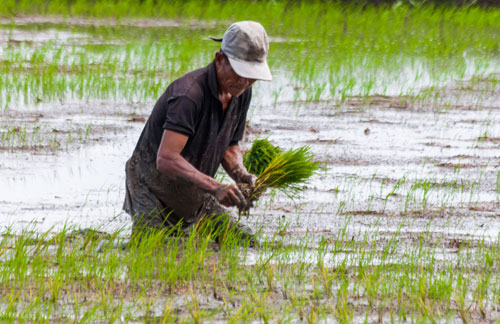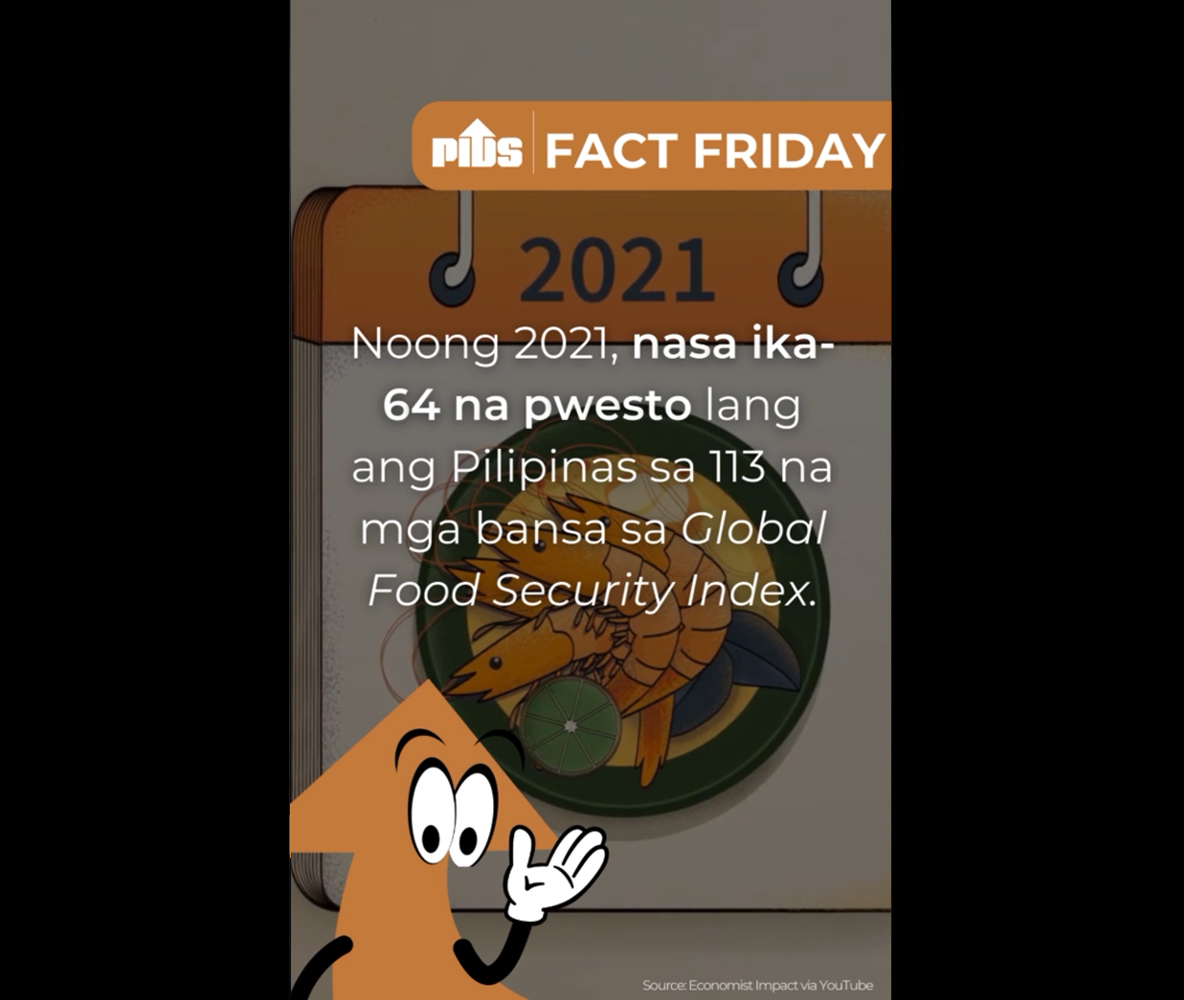
The World Food Summit of 1996 defined food security as a condition “when all people at all times have access to sufficient, safe, nutritious food to maintain a healthy and active life”. The concept of food security is regarded as having both physical and economic access to food that meets people's dietary needs and their food preferences. A recent publication of the Food and Agriculture Organization of the United Nations underscored the food insecurity problem the world is facing. Food production needs to increase by 70 percent to keep up with the global population that is projected to grow from 6 billion in 2009 to 9 billion in 2050.
Food security is a major concern of the agricultural sector since it produces the bulk of a country's food needs. Both the government and the private sector can work together to generate more investments in the food sector so as to increase the capacity to produce more food. In a discussion paper, Dr. Gilberto Llanto, PIDS president, and Ms. Jocelyn Badiola described various financing schemes for food production, such as value chain financing (e.g., contract growing), risk reduction instruments (e.g., index-based weather insurance and guarantee schemes), and credit delivery structures. In all these mechanisms, the authors stressed the role of government in creating an enabling policy and regulatory environment to encourage investments from the private sector.
Rice and corn are the Philippines’ staple crops and the main sources of income of the majority of small farmers. Rice self-sufficiency remains a contentious issue in the country. Three years ago, the government launched the Food Staples Sufficiency Program (FSSP) where food self-sufficiency is envisioned as a scenario where domestic requirements for food, seeds, processing, and feeds are met through local production. Dr. Roehlano Briones, a PIDS senior research fellow, argued that rice self-sufficiency on the notion of zero importation is not feasible. The FSSP assumed a fixed per-capita consumption which is not possible given the ever-increasing population growth. Briones’ analysis also indicated that the projected growth rates of palay production under the program are too ambitious to achieve based on historical trends. Briones stressed that what is needed is a pragmatic approach based on sound evidence. The more crucial strategy to pursue, he said, is to expand the area harvested and to raise yield through irrigation, which is another problematic subject based on recent PIDS studies showing that many publicly funded irrigation systems are performing poorly due to their inappropriate design arising from incorrect technical and economic assumptions. “Self-sufficiency should be pursued with more realistic targets and more cost-effective support mechanisms to rice producers, such as research and development and extension activities to generate and spread new rice farm technologies,” he added.
In the wake of national calamities that have gripped the country in recent years and months, food security is further put in peril. Typhoons, floods, and droughts have significant impact on food production. Based on a study by Briones and another PIDS research fellow, Dr. Danilo Israel, the total value of agricultural damage caused by natural calamities from 2000 to 2010 amounted to more than PHP 100 million, with rice, corn and high-value crops receiving the most damage. The figure excluded the damage to agricultural facilities, which was valued at PHP 4.9 million and at PHP 9.7 million for irrigation infrastructure. The study recommended site-specific support to farmers and provision of post-disaster emergency employment in affected communities aside from emergency food assistance.
Attaining sustainable growth of the agricultural sector is an efficient path to food security. Sustainable agriculture is also critical for increasing rural incomes and reducing poverty. The persistent sluggishness of Philippine agriculture will further widen the gap between rural and urban incomes, and aggravate urban problems when rural people relocate to the cities to seek opportunities they cannot find in the countryside. PIDS studies have attributed its slow growth to policy biases against the sector as a result of trade protection, high rate of population growth, unequal land distribution, and limited access of the rural poor to essential services such as physical infrastructure, health and education services, and agricultural finance.
To know more about PIDS research on food security, visit theSocioEconomic Research Portal for the Philippines. Simply type “food security”, “food insecurity”, “agriculture”, “rice self-sufficiency”, “financial scheme”, “agricultural finance” and related terms in the Search box.
Innovation in Financing Food security
Philippines: Food Security versus Agricultural Exports?
Impacts of Natural Disasters on Agriculture, Food Security, and Natural Resources and Environment in the Philippines
Food security
Addressing constraints to agricultural finance to boost food production
Putting rice on the table: rice policy, the WTO, and food security
Rice self-sufficiency: is it feasible?
Policy coordination for food security: the case of the ASEAN Rice Trade Forum
Bakit nagmahal ang bigas noong 2013? At bakit mahal pa rin? The continuing saga of rice self-sufficiencyin the Philippines
Rice self-sufficiency = no rice imports: Is it really feasible?
Food security is a major concern of the agricultural sector since it produces the bulk of a country's food needs. Both the government and the private sector can work together to generate more investments in the food sector so as to increase the capacity to produce more food. In a discussion paper, Dr. Gilberto Llanto, PIDS president, and Ms. Jocelyn Badiola described various financing schemes for food production, such as value chain financing (e.g., contract growing), risk reduction instruments (e.g., index-based weather insurance and guarantee schemes), and credit delivery structures. In all these mechanisms, the authors stressed the role of government in creating an enabling policy and regulatory environment to encourage investments from the private sector.
Rice and corn are the Philippines’ staple crops and the main sources of income of the majority of small farmers. Rice self-sufficiency remains a contentious issue in the country. Three years ago, the government launched the Food Staples Sufficiency Program (FSSP) where food self-sufficiency is envisioned as a scenario where domestic requirements for food, seeds, processing, and feeds are met through local production. Dr. Roehlano Briones, a PIDS senior research fellow, argued that rice self-sufficiency on the notion of zero importation is not feasible. The FSSP assumed a fixed per-capita consumption which is not possible given the ever-increasing population growth. Briones’ analysis also indicated that the projected growth rates of palay production under the program are too ambitious to achieve based on historical trends. Briones stressed that what is needed is a pragmatic approach based on sound evidence. The more crucial strategy to pursue, he said, is to expand the area harvested and to raise yield through irrigation, which is another problematic subject based on recent PIDS studies showing that many publicly funded irrigation systems are performing poorly due to their inappropriate design arising from incorrect technical and economic assumptions. “Self-sufficiency should be pursued with more realistic targets and more cost-effective support mechanisms to rice producers, such as research and development and extension activities to generate and spread new rice farm technologies,” he added.
In the wake of national calamities that have gripped the country in recent years and months, food security is further put in peril. Typhoons, floods, and droughts have significant impact on food production. Based on a study by Briones and another PIDS research fellow, Dr. Danilo Israel, the total value of agricultural damage caused by natural calamities from 2000 to 2010 amounted to more than PHP 100 million, with rice, corn and high-value crops receiving the most damage. The figure excluded the damage to agricultural facilities, which was valued at PHP 4.9 million and at PHP 9.7 million for irrigation infrastructure. The study recommended site-specific support to farmers and provision of post-disaster emergency employment in affected communities aside from emergency food assistance.
Attaining sustainable growth of the agricultural sector is an efficient path to food security. Sustainable agriculture is also critical for increasing rural incomes and reducing poverty. The persistent sluggishness of Philippine agriculture will further widen the gap between rural and urban incomes, and aggravate urban problems when rural people relocate to the cities to seek opportunities they cannot find in the countryside. PIDS studies have attributed its slow growth to policy biases against the sector as a result of trade protection, high rate of population growth, unequal land distribution, and limited access of the rural poor to essential services such as physical infrastructure, health and education services, and agricultural finance.
To know more about PIDS research on food security, visit theSocioEconomic Research Portal for the Philippines. Simply type “food security”, “food insecurity”, “agriculture”, “rice self-sufficiency”, “financial scheme”, “agricultural finance” and related terms in the Search box.
Innovation in Financing Food security
Philippines: Food Security versus Agricultural Exports?
Impacts of Natural Disasters on Agriculture, Food Security, and Natural Resources and Environment in the Philippines
Food security
Addressing constraints to agricultural finance to boost food production
Putting rice on the table: rice policy, the WTO, and food security
Rice self-sufficiency: is it feasible?
Policy coordination for food security: the case of the ASEAN Rice Trade Forum
Bakit nagmahal ang bigas noong 2013? At bakit mahal pa rin? The continuing saga of rice self-sufficiencyin the Philippines
Rice self-sufficiency = no rice imports: Is it really feasible?












